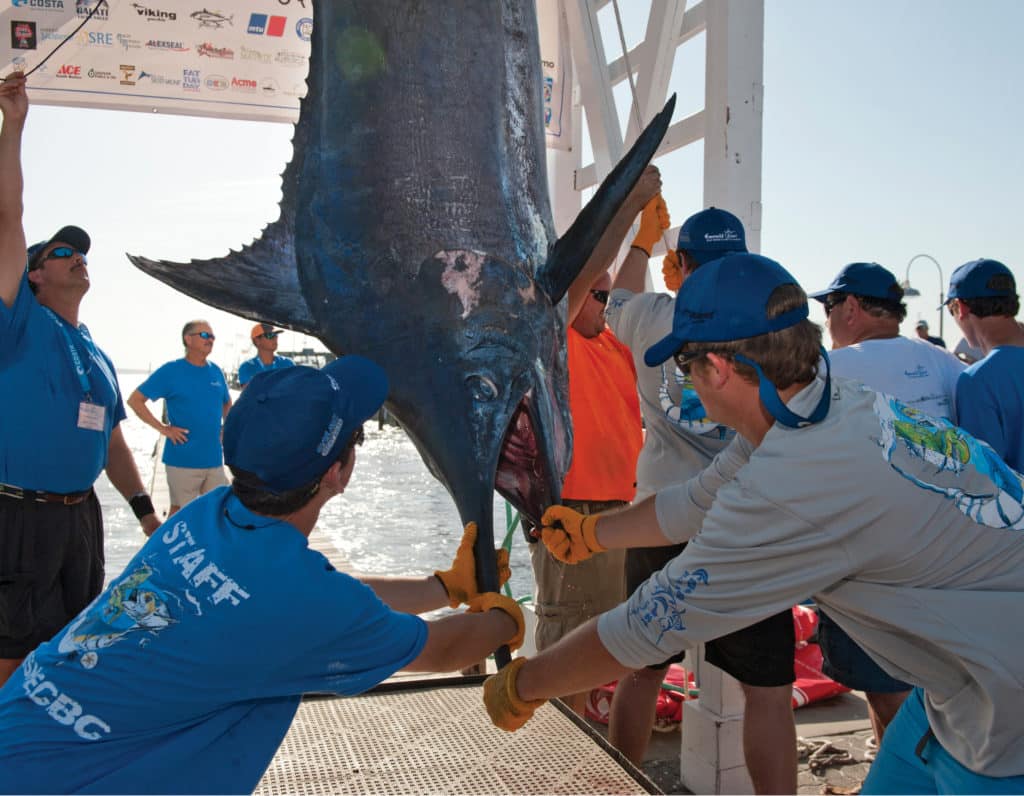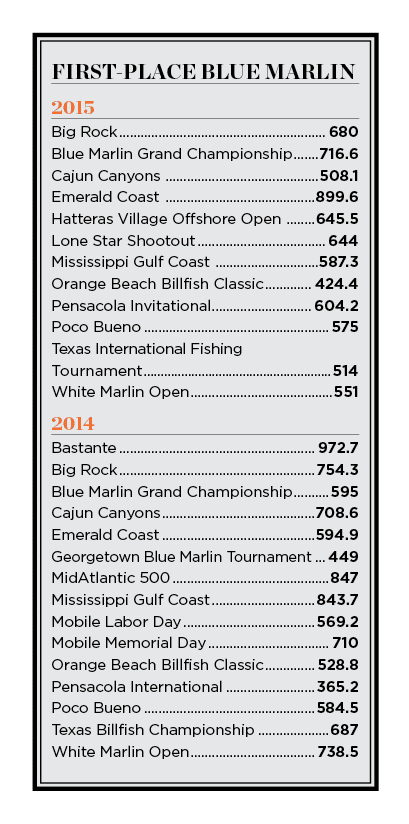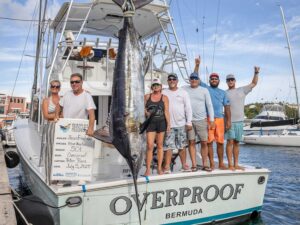
Changing Weight Classes

First-Place Blue Marlin
One of the most highly anticipated moments in all of big-game fishing — aside from watching a marlin charge a teaser or a lure — is when a weighmaster hits the switch to display the weight of a marlin during a big-money tournament. This excitement drives the crowds to attend tournaments and allures teams to bet big and fish hard. Not many people will ever see 899.6 pounds displayed on a Jumbotron, as we saw during the Emerald Coast Blue Marlin Classic in June, let alone have the opportunity to catch a fish of that caliber. This new tournament record is among the largest blues caught during the past couple of years in tournaments. Unfortunately, we are still seeing a high number of smaller fish weighed in tournaments as well, usually not winning any money. This has led many in the sport-fishing community to question whether it is time to raise the minimum size for Atlantic blue marlin in tournaments.
Current regulations allow individual tournaments to set their own minimum length as long as it meets or exceeds the federal minimum of 99 inches established by the National Marine Fisheries Service. Without delving too far into the fecundity and spawning behavior of these large fish, differences exist in the growth curves of male and female blue marlin. Just like humans, not every fish of the same length is the same weight. However, if you compare the 134.5-inch length and 74-inch girth of the nearly 900-pounder mentioned before, it absolutely dwarfs that of a legal-size fish. As many others I’ve talked with agree, seeing a 300-pounder hang from the scales is nowhere near as impressive as seeing a fish over 500 pounds.
In the Numbers
I can count on one hand the number of major billfish tournaments won during the past two years with a landed blue marlin weighing less than 500 pounds. Sure, there were plenty of fish weighed below the threshold, but in a majority of the tournaments, the top three places were all over the mark. Of those that fell short of 500 pounds and won a tournament, all of them exceeded 400 pounds. In many cases, smaller fish in the 300‑pound class were weighed that neither won nor earned much calcutta money, if any at all.
That’s a waste, in my opinion, but a gamble teams are willing to take considering the large potential winnings and the fact that it meets tournament requirements. A small fish certainly could win a big-money tournament if a larger fish isn’t landed to trump it, but the odds during the past couple of years lead me to believe a 300-pounder generally won’t cut it. In many situations — often depending on how the team bets — the crew might have been better off releasing the fish and hedging its bet in the release category rather than the kill. Tournament fishing is a gamble, but it doesn’t need to be wasteful.
On the Same Page
Modified-release tournaments are an effective approach, where applicable, but not always possible in multiday tournaments in which boats don’t return to the docks daily. In order to make greater conservation strides, tournaments need be on the same page with consistent minimum lengths. For example, in the four stops of the Gulf Coast Triple Crown series there are three different minimum lengths. Tack on the individual club tournaments and you add even more inconsistency for teams from one week to the next. Recreational fishermen are allowed by regulation to harvest a total of 250 Atlantic blue and white marlin combined, and we’re not coming anywhere close to killing that many fish. So the motivation to reduce the overall number of marlin landed would be to stop unnecessary waste rather than meet federal or international mandates.
Although they’re all slightly different, many tournaments already have taken steps to increase the minimum size of blue marlin that come to the scales in their events. The Mobile Big Game Club has the highest minimum length requirement in the Gulf: 106 inches. In the Carolinas, many of the tournaments require a 110-inch minimum or 400 pounds, and the White Marlin Open in the mid-Atlantic uses a minimum weight of 500 pounds and a minimum length of 105 inches. In many tournaments, if a boat weighs a fish that does not meet the required minimums, the team is disqualified from the tournament entirely. That makes a crew think twice before gaffing a fish.
According to a table of estimated weights I was given by a National Oceanic and Atmospheric Administration scientist, a 99-inch blue marlin is estimated to weigh 317 pounds, and a 110-inch blue marlin is estimated to weigh 452 pounds. A 500-pounder is estimated to measure 113 inches in length, and while these are just estimates that can easily vary, it gives us a starting point for a discussion on what should be done. With what is known, and by combining the rules of several current tournaments, a minimum of 500 pounds or 110 inches is not an unrealistic bar to set.
In addition to the increase in minimums, if tournaments followed suit and combined the kill and release categories into one overall blue marlin category, it would give greater incentives for teams to release fish instead of killing them, and actually increase the calcutta instead of splitting it into two different pots. If tournaments set a 500-pound minimum with a one-point-per-pound value given to a killed fish and awarded 500 points per released billfish, crews would have no reason to kill anything under 500 pounds. Catch a larger one and you have a leg up, but release two fish and you are ahead of the team that killed just one fish.
This change won’t occur overnight, but it is something we can do collectively without needing to alter federal regulations. Increases in minimum lengths or weights during tournaments would have lasting impacts on the fishery.







